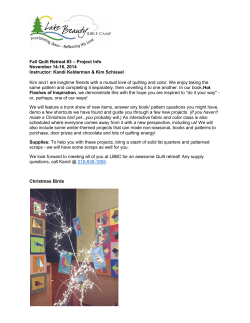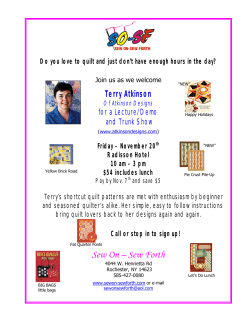
FOR IMMEDIATE RELEASE Media Contact: November 18, 2013
FOR IMMEDIATE RELEASE November 18, 2013 Media Contact: Amy Mannarino 202-783-7373 amannarino@nmwa.org Historical Quilts Exhibition at National Museum of Women in the Arts Dec. 20, 2013–April 27, 2014 Exhibition highlights changing perceptions and presentation of historical quilts in relation to American identity WASHINGTON—The National Museum of Women in the Arts (NMWA) presents “Workt by Hand”: Hidden Labor and Historical Quilts, an exhibition that explores the presentation, contextualization and interpretation of historical quilts. On view Dec. 20, 2013–April 27, 2014, this exhibition showcases 35 18th–20th-century quilts from the Brooklyn Museum’s renowned decorative arts collection. Revealing this medium’s shifting cultural status, “Workt by Hand” explores issues specific to quilting practices such as anonymity, authorship and collectivity as well as questions the conventional view of quilts as craft rather than fine art, all through a contemporary feminist lens. The exhibition presents examples of iconic quilt designs and techniques while providing new insights into the different interpretive methods used to understand historical quilts. Spanning two centuries of quilt making, patterns in “Workt by Hand” include the “Barn Raising” or “Log Cabin” style, the “Garden Basket” style, “Double Wedding Band” designs, the “Rose of Sharon” pattern, and the Amish “Sunshine and Shadow” style as well as album quilts and “crazy quilts.” The term “workt” featured in the exhibition title is an archaic spelling of “worked,” and the phrase “workt by hand” is common in historical quilting literature, indicating the distinctive and personal nature of an object produced by a skilled craftsperson. “Hidden labor” references the considerable creative energy women have used to create quilts. The labor often went unrecognized by a society that valued individually creative activities undertaken by men. “Quilt making was among the most significant forms of artistic production historically available to women,” said NMWA Director Susan Fisher Sterling. “This exhibition helps to reveal wider truths about the status of women’s creative efforts in American society during the past 150 years and the relative value placed on their work.” Over time, quilts have been alternately revered as nostalgic emblems of the past, dismissed as women’s work or hailed as examples of American ingenuity; quilts are intertwined with American women’s history. “Few artifacts straddle the traditional divide of art versus craft so completely. Because of this, quilts elicit a range of responses from scholarly to emotional,” said NMWA Associate Curator and liaison curator for the exhibition Virginia Treanor. “They have been used as ‘props’ in period rooms and as touchstones for the lives of their creators, judged in competition with one another or hung on the wall as works of art.” At NMWA “Workt by Hand” is organized around five themes: Myth, Nostalgia, the Colonial Revival and American Centennial; Folk Art and American Identity; Value and Labor; That ’70s Moment; and Collecting and Consuming. As part of the exhibition’s feminist framework, evocative historical photographs and newspaper clippings invite audiences to consider how the reception of objects is shaped by specific moments in history. Ephemeral materials, as well as interpretive texts, will encourage the consideration of many quilting traditions, outside of the Anglo-European one highlighted in the exhibition. Teasing out social history from quilt history, the exhibition includes a remarkable early 19thcentury patchwork Liberty Quilt (ca. 1830) attributed to Elizabeth Welsh of Virginia, which exemplifies how women created and disseminated iconic American revolutionary symbols. Women’s roles as both producers and consumers at the height of the Industrial Revolution are evidenced by the popular and highly publicized Crazy Quilt pattern made with affordable, vibrantly-colored textiles. The exhibition includes an exquisitely embroidered example created by Mary A. Stinson (ca.1880). “Workt by Hand”: Hidden Labor and Historical Quilts is organized by the Brooklyn Museum. Its presentation at the National Museum of Women in the Arts is made possible through the generous support of the Arkansas State Committee of NMWA and the DC Commission on the Arts and Humanities, an agency supported in part by the National Endowment for the Arts. Additional funding is provided by the Coby Foundation, the Elizabeth A. Sackler Museum Educational Trust and the members of NMWA. 2 Exhibition Tour Brooklyn Museum, Brooklyn, New York, March 15–Sept. 15, 2013 National Museum of Women in the Arts, Washington, D.C., Dec. 20, 2013–April 27, 2014 Publication The accompanying 124-page hardcover catalogue is edited by exhibition organizer Catherine Morris, curator of the Elizabeth A. Sackler Center for Feminist Art at the Brooklyn Museum. In addition to Morris’s essay about the inspiration for the project, the book features a roundtable discussion between quilt historian Barbara Brackman; Associate Professor of Art History at the University of Colorado Denver Maria Elena Buszek; Professor Emerita of the Environment, Textiles and Design Department at the University of Wisconsin Beverly Gordon; and quilt scholar and board member of the Alliance of American Quilts Janneken Smucker. The catalogue section of the book, offering details about more than 30 quilts, includes descriptive texts by Carolyn Ducey, curator of collections at the International Quilt Study Center & Museum at the University of Nebraska-Lincoln. The book will retail for $39.95. Tours To request a tour, visit http://nmwa.org/visit/book-tour. National Museum of Women in the Arts Founded in 1981 and opened in 1987, NMWA is the only museum solely dedicated to celebrating the achievements of women in the visual, performing and literary arts. The museum’s collection features 4,500 works from the 16th century to the present created by more than 1,000 artists, including Mary Cassatt, Frida Kahlo, Alma Thomas, Lee Krasner, Louise Bourgeois, Chakaia Booker and Nan Goldin, along with special collections of 18th-century silver tableware and botanical prints. NMWA is located at 1250 New York Avenue, NW, Washington, D.C., in a landmark building near the White House. It is open Monday–Saturday, 10 a.m.–5 p.m. and Sunday, noon–5 p.m. For information, call 202-783-5000 or visit www.nmwa.org. Admission is $10 for adults, $8 for visitors 65 and over and students, and free for NMWA Members and youths 18 and under. Free Community Days are on the first Sunday of the month. For more information about NMWA, visit www.nmwa.org, Broad Strokes Blog, Facebook or Twitter. ### Image credit lines: Mary A. Stinson (American), Crazy Quilt, circa 1880, Silk, 81 ¼ x 81 ⅝ in., Brooklyn Museum, Designated Purchase Fund, 1995.87, Brooklyn Museum photograph (Gavin Ashworth, photographer), 2012 3
© Copyright 2025












